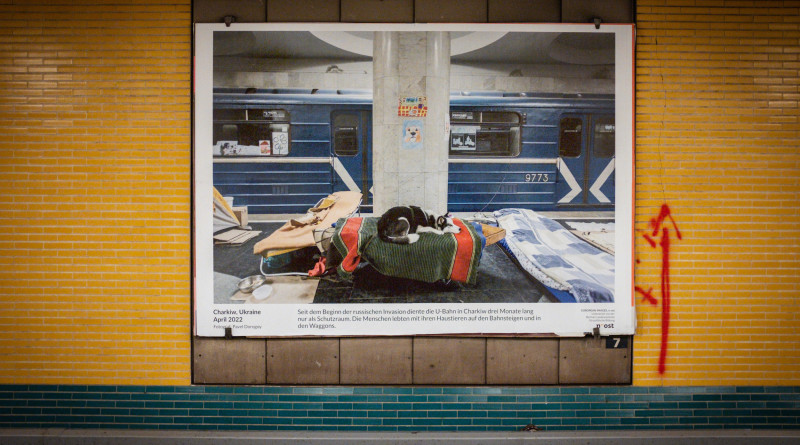“Next Station”. Photos of the Ukrainian War in the Subway of Berlin
Ukrainians sheltered underground in the relative safety of the subway stations when Russian bombs fell on Kyiv and Kharkiv. Photos from those shelters are exhibited in three stations in Berlin, organised by journalistic NGO ‘n-ost’.
The exhibition “Next Station: Ukraine” is placed at 3 metro stations in Berlin subway. The images are made by Ukrainian and international photographers Maxim Dondyuk (🇺🇦), Pavel Dorogoy (🇺🇦), Serhii Korovayny (🇺🇦), Jędrzej Nowicki (🇵🇱) and Emile Ducke (🇩🇪). (11.-24.11.22)
We spoke with Anastasia Anisimova, who co-organised the project with Stefan Günther.
How did the idea for the exhibition come up and how did you choose the Photographers?
The idea to put images from Ukraine in a public space came first from my colleague Stefan Günter. He initiated an unofficial exhibition on the 9th of May with images of destroyed Ukrainian houses near the Soviet War Memorial in Treptower Park in Berlin. It was a symbolic and powerful gesture because many people came there on this day and could see it, including those Russians in Berlin who supported Putin.
Since then we have started thinking together about how to do similar actions officially. The decision about the subway as a platform came first because the audience is huge and billboards are perfect for powerful documentary photography. Then we started brainstorming images. The first thought was to make a subway exhibition for the anniversary of Euromaidan with images from 2013 to show Berliners the dignity and power of the Ukrainian revolution. But after consultations with Ukrainian colleagues and the new escalation of the war, we decided it is not the right timing for it. Then we started thinking about the subway images. We have a Ukrainian colleague Alyona Vyshnytska. She is based in Kyiv and is sheltering in the subway during Russian attacks. One day she wrote the message describing her sheltering underground, without enough water supplies, electricity, and internet connection. It was a turning point to decide on images and captions. Initially, we thought of writing some statistics about the war in the photo captions but then decided to better describe life in the subway. The caption like “Instead of announcing train delays, the speaker system can tell the inhabitants that food arrived” should create an immersive experience for the audience seeing it in the Berlin subway.
About Photographers. For us, it was important to include Ukrainian photographers. We also make some criteria for the images: no graphic violence, pictures should be obvious and easy to understand for a broad audience and images together should be diverse. We try to maintain balance, not use too many pictures of kids and old people, and include images of musicians playing underground claiming not only challenges but also the power and spirit of Ukrainians.
How is the atmosphere in Berlin regarding the Ukraine war? How do you want to influence the viewers with the exhibition?
We don’t use the phrase “Ukraine war”, “Russian full-scale invasion” describes better what’s happening now.
We all live in our bubbles, and it is hard to say about Berlin overall. But of course I feel that people are less emotionally involved as it was in the beginning of the war. And it is the goal of the project to remind us that right now when we go to work in the center of Berlin and wait for our train, at the same moment in the same public space people in Ukraine are sheltering from Russian rockets.

